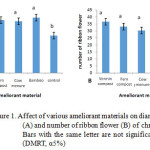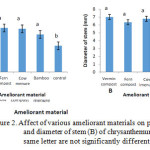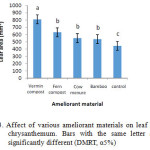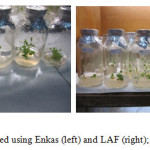Introduction
Merapi eruption in 2010 brought tremendous impact on environment, socioeconomic, and agriculture. One of the affected areas was Pakem district. It was exposed by ash and sand directly village on the slopes of Merapi, which has the potential to be developed as center of ornamental plants is Hargobinangun, sub-district Pakem. Since 2005 the region has been considered to be the center of chrysanthemum flower cultivation of Yogyakarta Province, considering the altitude of the area (500-800 m above sea level) are eligible for the growth of chrysanthemum. Currently, chrysanthemum cultivation has been carried out by more than 100 local farmers, which are grouped in 13 farmer groups to manage an area of 10,000 m2 with a production capacity of 15,000 cut flowers per week.3
After the eruption of Merapi on November 5, 2010, Chrysanthemum cultivation in the Hargobinangun village becomes stagnant .24 Most farmers did not know what to do because the chrysanthemum planting area conditions were destroyed. This area is very close to the Mount Merapi. The planting area is within the 4-10 km from the peak of Merapi. Post the eruption, planting area was covered by volcanic ash and sand, and could not be used for cultivating anymore.
Chrysanthemum in the form of cut flowers, produced by farmers in Wonokerso were much degraded, so that consumers were switching on chrysanthemum imported from other regions, such as West Java and East Java. In the field survey showed poor production quality was due to the plant roots were not well developed, brown coloured with short size. Volcanic material with a thickness of 5-15 cm that covers Wonokerso became compressed (compact), hard, water-resistant. Addition of ameliorant was needed to restore the crumb structure.24 reported that the volcanic material that was given ameliorant vermin compost and cow manure was good for dahlias plant growth in the Kinahrejo region. Basically dahlias and chrysanthemums almost the same, so as to improve the planting area of chrysanthemum can be used the same ameliorant.
Chrysanthemum white rust (CWR) can be a serious disease of chrysanthemum crops. According to,10 white rust disease (Puccinia horiana P. Henn.) may decrease freshness of chrysanthemum flowers (vase-life) into only 5 days, significantly shorter than the healthy ones. Its freshness can last up to 12 days at room temperatures (27-29°C). Chrysanthemum yield loss caused by white rust disease is reaches 30% in Indonesia,21 80% in Turkey,9 and 100% in New England.6 Some insects reported as vector of some virus diseases, i.e. Aphis craccivora, Acyrthosiphon pisum, and Myzus persicae,17 Macrosiphoniella sanborni, Rophalosiphum sp. (Aphididae)2 also attack leaves of chrysanthemum. Various pest and disease control measures has been done such as the use of tolerant varieties, culture technique (i.e. cutting infected leaves and setting watering), the use of natural enemies, and the application of synthetic pesticides. However, the intensity of pest and disease still high. Recently, mineral oils were found to be highly effective against citrus pest.15-5 Horticultural mineral oil (HMO) is highly refined mineral oils originated from crude petroleum oils. It is paraffinic compound (³60% of carbon atoms occur in chains). It has un-sulfonated residue (UR) values ³92 % (therefore it contains £8% aromatic molecules). Its molecule weight vary and is reflected in the number of carbon atoms. The lightest oils are oils, and the heaviest oils are generally nC25 oils. These values reflect the median equivalent n-paraffin carbon numbers and distillation temperatures.1-4 Several factors favor the use of horticultural mineral oil including low cost, low mammalian toxicity, and few deleterious environmental effects.7 Thus the main problem being urgency (virtue) doing in this research is a complete study of various aspects of the chrysanthemum plant cultivation techniques that can improve growing conditions.
Materials and Methods
The experiment was conducted in the village Wonokerso, Pakem, Sleman Yogyakarta with the complete randomized block design consists of two factors: material of ameliorant and HMO concentration. The first factor consisted of four levels: vermin compost, fern compost, cow manure and litter of bamboo plants. The second factor consisted of three levels: 0.125, 0.250 and 0.500% v/v of horticultural mineral oil (HMO: nC21 Sunspray Ultra Fine®, Amtrade Pty). As control chrysanthemums was grown in media without ameliorant and without HMO application. From these two factors each repeated three times and each block contains 50 plants with five sample plants, so that the overall number was 1800 crop plants plus 150 control plants.
Research was conducted in UV plastic roofed green house, facing east to form a semicircle dome roof. Land management was done as deep as 30 cm and it was mixed with ameliorant material according to treatment then beds were made 10-20 cm height. Chrysanthemum seedlings taken from Horticultural Research Institute at Cipanas, West Java were planted in beds that have been given the nets. Plants were treated for three months, which includes watering, and fertilizing. Watering the plants was conducted twice a day. Fertilization was done at the beginning of the study using 75 g N, 75 g P, and 25 g K fertilizer per plant and leaf fertilizer once a week.
Assessment was conducted fortnightly before oil spray application on five randomly chosen central plants within each plot on plant height, diameter of flower, number of ribbon flower, leaf area, stem diameter, aphid population, and the spread of white rust disease. Visual observations determined the number of aphid per leaf on five chosen leaves on upper part of tree. The spread of white rust was assessed at same samples as aphid assessment by recording fortnightly the number of leaves infected based on the rating scale of severity (Table 1.)
Table 1: Disease severity rating scale used to access the spread of white rust.
| Severity rating | Description |
| 01234 | Leaf without any symptom< 25% part of leaf showing symptom25% up to < 50% part of leaf showing symptom50% up to < 75% part of leaf showing symptom≥ 75% part of leaf showing symptom |
Advanced research was conducted in the laboratory to test the ability of plant life to be propagated in vitro using Enkas and Laminair Air Flow cabinet.
Data were subjected to one-way ANOVA (analysis of variance). Duncan’s multiple range test (DMRT) was used to determine the differences among treatments when the ANOVA was significant. Significance different was arise at P< 0.05. Analysis was performed using SPSS® version: 10.0.5.19
Results and Discussion
Ameliorant material did not affect on diameter of flower (Fig. 1A.), the number of ribbon flowers (Fig. 1B.), plant height (Fig. 2 A.), and the diameter of stem (Fig. 2B.) and there was not any interaction between ameliorant and HMO but significantly higher all these characters than the control. Vermin compost was the best ameliorant material for increasing leaf area (Fig. 3). Diameter of flowers, ribbon flower number, plant height, stem diameter and leaf area on treatment of ameliorant were ranging from 5.76 to 6.18 cm, 30.33 to 36.67, 87.55 to 90.44 cm, 6, 33 to 7.00 mm and 550.60 to 808.90 mm2, respectively. While in control, the flower diameter, number of ribbon flower, plant height and stem diameter were 4.17 mm, 23.00, 84.67 cm, and 5.15 mm respectively.
Leaf tissue anatomy in monocotyledon is composed of a set of cells that have almost the same shape. It is composed of upper and lower epidermis tissue, and mesophyll tissue, which is composed of palisade tissue and spongy tissue. The epidermis covers the upper and lower surfaces of leaves up to epidermal stem.16 Mesophyll layer is the most important leaf part for photosynthesis. Most of palisade layer is composted by chloroplasts, and affects the products of photosynthesis. Damage by high temperatures that occurs in mesophyll, specifically in palisade, will give the highest impact on the photosynthesis activities. The common histological changes in leaf damage by high temperature are plasmolysis, granulation or disorganization of cells constituent, destruction or disintegration of cells and tissue pigmentation.22
 |
Figure 1: Affect of various ameliorant materials on diameter of flower (A) and number of ribbon flower (B) of chrysanthemum. Bars with the same letter are not significantly different (DMRT, α5%) Click here to View figure |
 |
Figure 2: Affect of various ameliorant materials on plant height (A) and diameter of stem (B) of chrysanthemum. Bars with the same letter are not significantly different (DMRT, α5%) Click here to View figure |
 |
Figure 3: Affect of various ameliorant materials on leaf area of chrysanthemum. Bars with the same letter are not significantly different (DMRT, α5%) Click here to View figure |
13 mentioned that pollutants are able to induce physiological damage in the plant long before of the occurrence of physical damage. Other experts said that it is a hidden damage. Hidden damage may be a decrease in the ability of plants to absorb water, slow cell growth or imperfect stomata opening. According to,17 mechanism of stomata opening dependents on the changes of cover cells turgid. Cover cell containing a high concentration of starch will be closed, especially at night. When the sun is able to generate photosynthesis in chlorophyll, CO2 level will decline, and it is reduced into CH2O. This process is followed by the increase of pH and will increase the activity of posporilase enzymes to convert starch into glucose. The glucose formation will increase the osmosis level of cover cell, causing water influx from neighbouring cells. This condition causes stomata turgid and stomata will open.
There was no significant difference between oil concentration treatments (Table 2.). It seemed that oil film could not provide a barrier by masking the feeding and oviposition stimulants, hence preventing the aphid from locating, accepting or using the host plant. It was not consistent with the report on the adult females of two spotted mite (Tetranychus urticae Koch [Acari: Tetranychidae]),11 Asiatic citrus psylla (Diaphorina citri Kuwayama),14 whiteflies (Bemesia argentifolii Bellows and Perring [Hemiptera: Aleyrodidae]),20 greenhouse thrips (Heliothrips haemorrhoidalis Bouche [Thysanoptera: Thripidae]).12 They do not lay their eggs on plant treated with oils. Density of damage spots caused by citrus red mite (Panonychus citri McGregor [Acari: Tetranychidae]) feeding activity was reduced significantly on plant treated with these oils.5 Greenhouse thrips preferred untreated fruit to HMO-treated fruit as feeding site.11
Oil application in concentrations of 0.250 and 0.500% were able to decrease the spread of white rust with the severity of 69.44 and 65.00 respectively (Table 2.). Oil might be caused deformation of aprezoria and affected on uredospores germination to infect chrysanthemum plants. Similar result has been reported by [18] on wheat rust (Puccinia recondite f. sp. Tritici.). Oils could also provide a mechanical barrier to prevent the invasion of uredospores germ tube.22 The success of oil in suppressing plant disease was also achieved on powdery mildew.7
Significant suppression of aphid would likely require either higher concentration of oil or more frequent application of oil then were used in this study to form appropriate oil layer density on leaves surfaces. The level of suppression related to the number of applications.7 It should be thick enough to prevent the emitting of leaves volatile.
Table 2: Effect of oil concentration on aphid population and diseases severity of white rust on chrysanthemum leaf.
|
Oil concentration (% v/v) |
Aphid population |
Disease severity (%) |
|
0 0.125 0.250 0.500 |
24.11 ± 2.86 q 23.89 ± 2.20 q 21.67 ± 2.66 q 18.00 ± 2.25 q |
88.89 ± 2.47 a 86.67 ± 2.36 a 69.44 ± 2.27 b 65.00 ± 2.89 b |
|
Probability (P) |
0.298 |
< 0.001
|
Numbers in columns followed by the same letter are not significantly different (DMRT, α5%)
Wonokerso area is used as a center for the cultivation of chrysanthemum. This will be a “pilot project” or as a model for other areas to cultivate chrysanthemum. Observations in the field indicated that the closure of volcanic material with a thickness of 5-15 cm in the ground can cause delays in the entry of air into the soil. This can lead to land degradation as a habitat for flora and fauna that can support the growth of cultivated plants as a source of farmer’s revenue.
Advanced research was conducted in the laboratory to test the ability of plant life to be propagated in vitro using Enkas and Laminair Air Flow cabinet. Observations during the incubation period since the explants are planted until the end of the study showed various changes in the explant. These changes include the shoots growing process, the percentage of the growing process, shoots height, total number of shoots, and total number of roots.
The initial response that occurred in the majority of explants after implantation is the tissue swelling of explants. According ,8 changes in the explant are linked to the level of osmolarity of the medium used24 stated that the tissue swelling is due to the effect of the addition of nutrients and growth regulators.
The results showed that the sowing explants implemented on Enkas and Laminair Air Flow (LAF) was not significantly different for all important parameters of callus growth observed, as presented in table 3. This means that the Enkas equipment, although it is pretty simple, easy to use, and cheap, it can create products that are equally good compared to Laminair Air Flow (LAF) that looks more complicated and expensive.
Table 3: The number of days for shoots growing process , the percentage growing process, shoot height, number of shoots and number of roots on Laminair Air Flow and Enkas at 30 days after sowing.
| Treatments |
During the Shoots Growing Process (day) |
Percentage of the growing process (%) |
Shoots Height (cm)
|
Total Number of Shoots
|
Total Number of Roots
|
| Laminair Air Flow | |||||
|
M1 (½MS + 1 ppm NAA + 0 ppm Kinetin) |
14 b |
60 c |
1,6 c |
2 b |
4 b |
|
M2 (½MS + 1 ppm NAA + 0,1 ppm Kinetin) |
9 a |
60 c |
4,6 b |
3 b |
6 b |
|
M3 (½MS +1ppm NAA + 0,2 ppm Kinetin) |
12 b |
65 b |
5,1 b |
4 ab |
6 b |
|
M4 (½MS +1 ppm NAA + 0,3 ppm Kinetin) |
12 b |
85 a |
6,7 a |
5 a |
11 a |
|
M5 (½MS +1 ppm NAA + 0,4 ppm Kinetin) |
13 b |
70 b |
5,2 b |
2 b |
4 b |
| Enkas | |||||
|
M1 (½MS + 1 ppm NAA + 0 ppm Kinetin) |
15 c |
50 d |
2,9 b |
2 b |
3 b |
|
M2 (½MS + 1 ppm NAA + 0,1 ppm Kinetin) |
15 c |
60 c |
3,3 ab |
2 b |
3 b |
|
M3 (½MS +1 ppm NAA + 0,2 ppm Kinetin) |
14 b |
70 b |
3,7 ab |
3 a |
9 a |
|
M4 (½MS +1 ppm NAA + 0,3 ppm Kinetin) |
9 a |
80 a |
4,5 a |
4 a |
11 a |
|
M5 (½MS +1 ppm NAA + 0,4 ppm Kinetin) |
16 c |
45 d |
2,9 b |
3 a |
4 b |
|
– |
– |
– |
– |
– |
|
The figures followed by the same letter in the columns and rows are not significantly different based on DMRT Test (α = 5%). The (-) sign indicates no significance between LAF and Enkas.
 |
Figure 4: Plantlets produced using Enkas (left) and LAF (right); at 60 days after sowing. |
Table 3 shows that during the shoots growing process, the treatments between Enkas and LAF had no significant difference. Meanwhile, between the four kinds of media used, shoots from M1 medium emerged faster than the other media. The initial response that occurred in the majority of explants planted is the tissue swelling of explants. According to,21 changes in the explant are linked to the level of osmolarity of the medium used. Media culture is one of the critical success factors of plant propagation in vitro. In tissue culture media, the addition of rapid growth regulator substances is required to support the growth of explants. This is in line with the opinion of,8 which stated that the higher the concentration of cytokines, the longer the shoots will grow. It also affects the percentage of the shoots growing process, in which the influence of kinetin to the cell is its role in stimulating the process of cell division and cell differentiation. The main influence is in DNA replication that will affect the growth of shoots. The planting medium used also determines the growth. M3 medium (MS + 2 ppm NAA + 0.3 ppm Kinetin) was able to spur the growth of shoots to make them taller and in great quantities, as well as the total number of roots. Plantlet rooting is important for further growth due to the growing number of roots, which are good for the media to absorb nutrients. This is because the more number of roots produced, the vaster the field of nutrients absorption from the roots media becomes. The number of root crops will be useful for acclimatization in a glass house. Therefore the increasing number of roots will also improve the field of nutrients absorption.23
The application at the farm level showed that farmers have no difficulty in using enkas, although it is still necessary to conduct further training and mentoring to increase the success rate. The use of Enkas and LAF was able to provide results that are equally good for the in vitro development of the potato, although the need of advanced skills is still necessary to make it more flexible in its use.
Conclusion
The addition of ameliorant increased soil fertility, plant growth, and cut flower production. Plant growth in the form of plant height, stem diameter, and leaf area was higher than the control. Cut flower production in the form of flower diameter and number of ribbon flower was also better than the control. Oil application on concentration of 0.250 and 0.500% was able to suppress the severity of white rust on chrysanthemum. Higher concentration or frequency was required to achieve significant control on aphid population.The application at the farm level showed that farmers have no difficulty in using enkas, although it is still necessary to conduct further training and mentoring to increase the success rate.
Acknowledgements
Our gratitude goes to LPDP-RISPRO who has funded this research through grants implementation.
References
- Agnello, A. M. Petroleum-derived spray oils: chemistry, history, refining and formulation. In: Beattie GAC, Watson DM, Stevens ML, Rae and Spooner-Hart editors. Spray oils beyond 2000 sustainable pest and disease management, pp.2-18 (2002).
- Balithi. Agricultural research and development report. 29(6): 16-17 (2007).
- BAPPEDA, D.I., Yogyakarta. Regional Strategic Plan (Renstrada) DIY Province in 2004-2008. DIY Provincial Laws No. 6 of 2003. The Regional Development Planning Agency (BAPPEDA) Yogyakarta Special Region. 71 pp. In bahasa (2003).
- Beattie, GAC., Hardy S. Using petroleum-based spray oils in citrus. Agfact H2.AE.5. 7 p (2005).
- Cen, Y.J., Tian, M.Y., Pang, X.F., Rae, D.J. Repellency, antifeeding effect and toxicity of a horticultural mineral oil against citrus red mite. In: Beattie GAC, Watson DM, Stevens ML, Rae and Spooner-Hart (eds). Spray oils beyond 2000 sustainable pest and disease management, pp. 134-141(2002).
- Ellis, D. New pest concern in new England. Chrysanthemum white rust integrated pest management. Univ. Conecticut. http://www.hort.uconn.edi/Ipm/(2007).
- Fernandez, DE., Beers, EH., Bruner, JF., Doerr, MD., Dunley, JE. Horticultural mineral oil applications for apple powdery mildew and codling moth, Cydia pomonella (L.). Crop Protection 25: 585-591 (2006).
CrossRef - S. Fukai, Y. Kamigaichi, N. Yamasaki, W. Zhang and M. Goi, Distribution, morphological variations and cpDNA PCR-RFLP analysis of Dendrathema yoshinagathum, Journal of Jap. Soc. Hort.Sci., 71:114-122(2002).
CrossRef - Gore, ME. White rust outbreak on chrysanthemum coused by Piccinia horiana in Turkey. New disease report. http://www.bspp.org.uk/ndr/jan2008/2007-81.asp. (17 May 2010)
- Kristina, D., Herlina, D., Wuryaningsih, S. Characterization of several types of commercial cut flowers in the flower market Cipanas and Jakarta. Ornamental Crops Research Bulletin. 2(1): 7-19. In bahasa(1994).
- Liu ZM, Beattie GAC. Effect of a horticultural mineral oil on oviposition by two spotted mite Tetranychus urticae Koch (Acari: Tetranychidae). General Application of Entomology. 31: 65-67(2002).
- Liu ZM., Beattie GAC, Johnson D, Spooner-Hart R. Feeding and oviposition reponses of greenhouse thrips to horticultural mineral oil deposits on Valencia orange fruit and mango leaves. In: Beattie GAC, Watson DM, Stevens ML, Rae and Spooner-Hart (eds). Spray oils beyond 2000 sustainable pest and disease management, pp. 147-151(2002).
- Marschner, H. Mineral nutrition in higher plants. Academic Press. Harcourt Brace Jovanovich Publishers. London New York Orlando San Diego Austin Boston Sydney Tokyo Toronto. 391-477(1986)
- Rae Dj, Liang WG, Watson DM, Beattie GAC, Huang MD. Evaluation of petroleum spray oils for control of the Asian citrus psylla, Diaphorina citri Kuwayama (Hemiptera: Psyllidae) in China. International Journal of Pest Management. 43: 71-75 (1997).
CrossRef - Rae Dj, Liang WG, Watson DM, Tan BL, Li M, Ding Y, Xiong JJ, Du DP, Tang J, Beattie GAC, Huang MD. Comparison of petroleum spray oils, abamectin, cartap and methomyl for citrus leafminer control in southern China. Journal of Economic Entomology, 89: 493-500 (1996).
CrossRef - Rahardjo IB, Muharam A, & Sulya Y. Studi pembuatan anti serum poliklonal untuk deteksi cepat virus mozaik mentimun pada krisan. J Hortikultura 15 (2):124-128 (2005).
- Salisbury, F.B and CW. Ross Physiology of plants. Publisher ITB(1992)
- Sallam, MEA., Mona, MA., Taleb, A., El-Nashar, FK. Evaluation of some plant and mineral oils on the control leaf rust disease of wheat. J. Phytopathol. 29: 1-17 (2001).
- SPSS Inc. SPSS® for Windows™ Version 10.0.5. Chicago: SPSS Inc. (1999).
- Stansly PA, Liu TX, Schuster DJ. Effects of horticultural mineral oils on a polyphagous whitefly, its plant hosts and its natural enemies. In: Beattie GAC, Watson DM, Stevens ML, Rae and Spooner-Hart editors. Spray oils beyond 2000 sustainable pest and disease management, pp. 120-133(2002).
- Suhardi. Inoculum source, the response of varieties, and the effectiveness of fungicides against the disease on chrysanthemum white rust. J. Hort. 19(2): 207-209 (2009).
- Tawfik, AE., Hanna, AI., El-Ghareeb, LA., Gomah, AA., Mahmoud, SM. Applied approach for controlling brown rot and soft rot bacteria of potatoes. J. Agric. Sci. 26: 3631-3642(2001).
- Wijayani, A., Effect of nitrogen concentration to changes in root tissue ultrastructure peppers. Agrivet 3: 17-25 (1999)
- Wijayani, A., Effendi, I., Nusanto, G., Gusaptono, H., Susilastuti, Amiadji, E. Restructuring of Kinahrejo area based on Agro-tourism after the eruption of Merapi using ornamental plants. Proc. Int. sem. Agro-tourism on development in 2011, Yogyakarta, Indonesia (2011).
